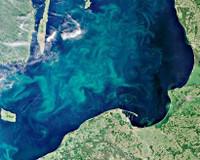-

- Ferrari
The annual cycle of phytoplankton growth in many parts of the ocean is dominated by a population explosion in late winter early spring, the so-called spring bloom. High levels of primary production during the spring bloom, and the subsequent sinking of organic material contributes significantly to the carbon flux to the deep ocean. The onset of the spring bloom has been traditionally associated with the shoaling of the mixed layer above a critical depth at the end of winter. However I will argue that the onset of the spring bloom is more likely triggered by the reduction in air-sea heat loss at the end of winter. When net cooling subsides at the end of winter, turbulent mixing in the ocean becomes weak, thereby increasing the residence time of phytoplankton cells in the euphotic layer and allowing a bloom to develop. The necessary change in the air-sea flux generally precedes mixed layer shoaling, and provides a better indicator for the onset of the spring bloom than the mixed layer depth. I will illustrate the results with a combination of theory, numerical simulations, and analysis of remote sensing data.

